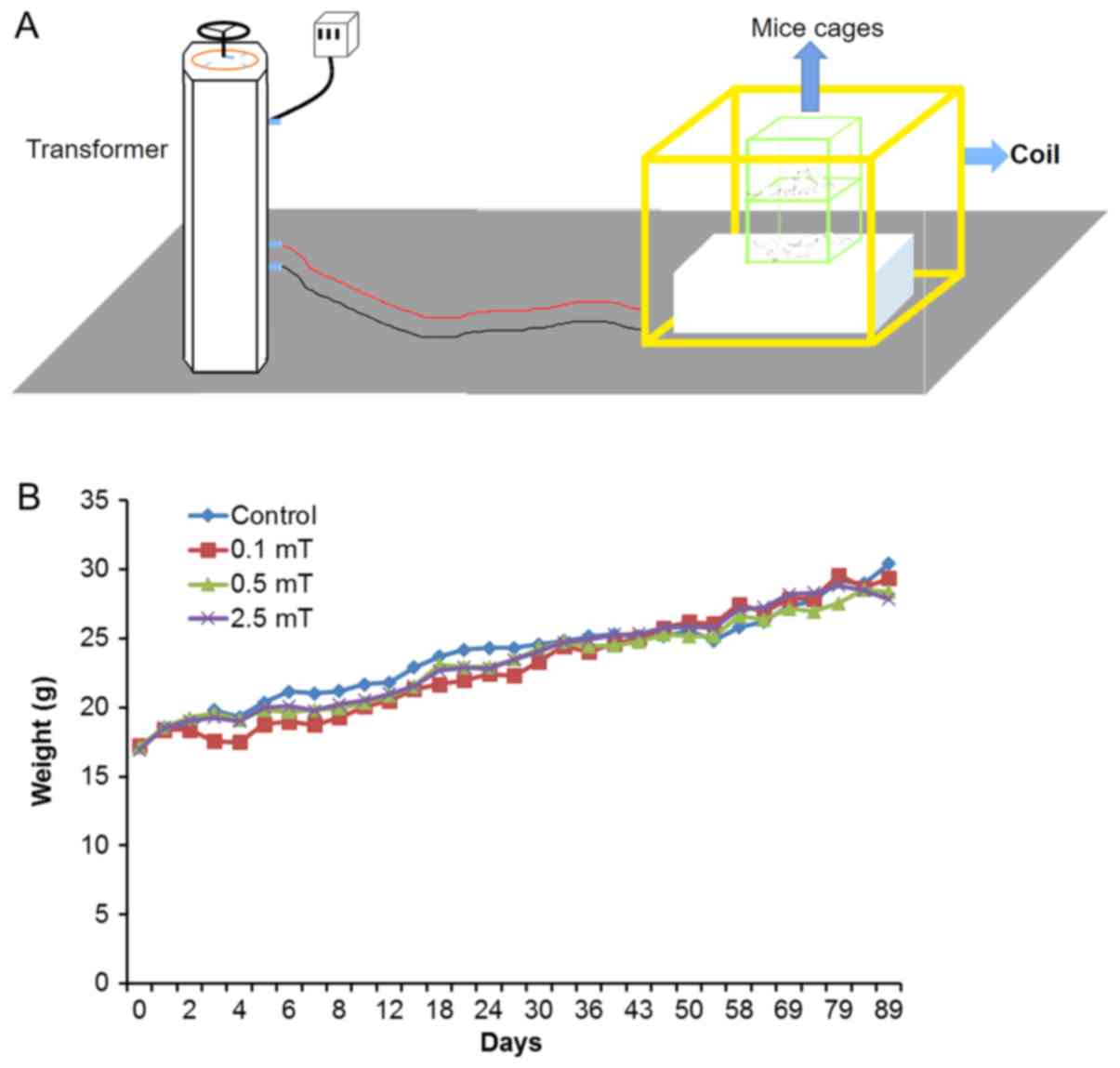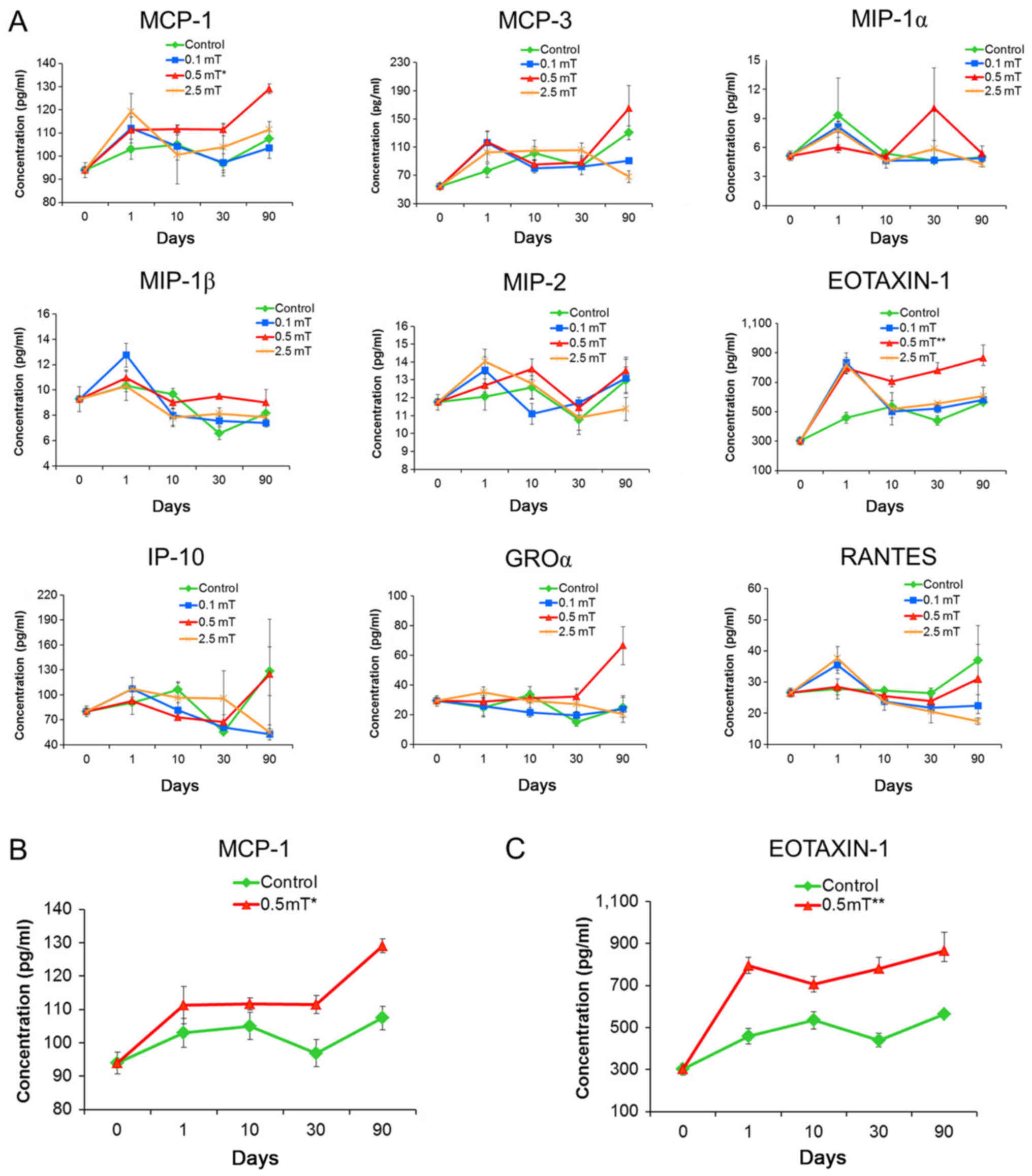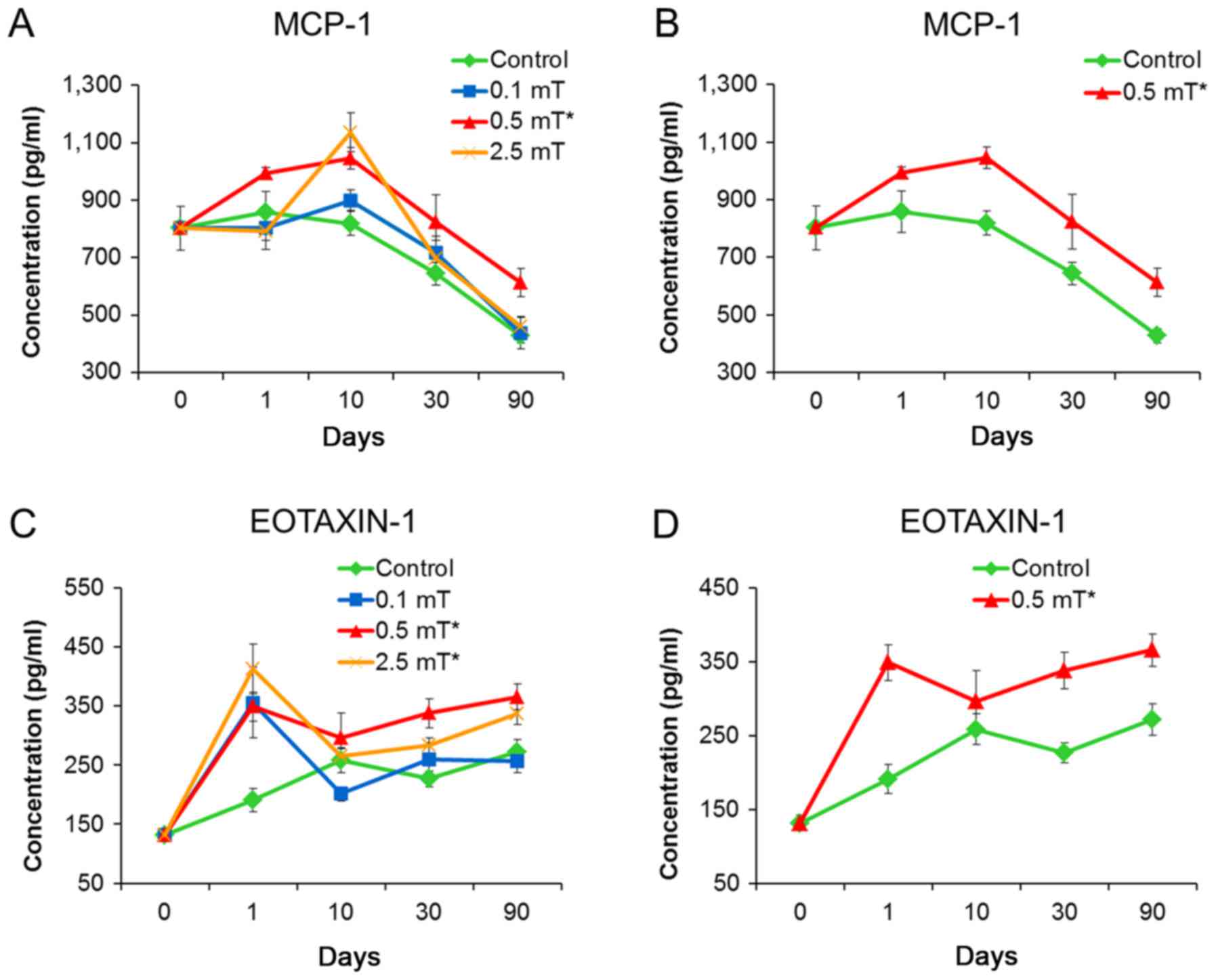|
1
|
Kheifets LI, Afifi AA, Buffler PA and
Zhang ZW: Occupational electric and magnetic field exposure and
brain cancer: A meta-analysis. J Occup Environ Med. 37:1327–1341.
1995. View Article : Google Scholar : PubMed/NCBI
|
|
2
|
Ross CL and Harrison BS: An introduction
to electromagnetic field therapy and immune function: A brief
history and current status. J Sci Appl: BioMed. 3:18–29. 2015.
|
|
3
|
Singh S and Kapoor N: Health implications
of electromagnetic fields, mechanisms of action, and research
needs. Adv Biol 2014. Article ID 198609. 2014.http://dx.doi.org/10.1155/2014/198609
|
|
4
|
Wertheimer N and Leeper EM: Electrical
wiring configurations and childhood cancer. Am J Epidemiol.
109:273–284. 1979. View Article : Google Scholar : PubMed/NCBI
|
|
5
|
Ikeda K, Shinmura Y, Mizoe H, Yoshizawa H,
Yoshida A, Kanao S, Sumitani H, Hasebe S, Motomura T, Yamakawa T,
et al: No effects of extremely low frequency magnetic fields found
on cytotoxic activities and cytokine production of human peripheral
blood mononuclear cells in vitro. Bioelectromagnetics. 24:21–31.
2003. View Article : Google Scholar : PubMed/NCBI
|
|
6
|
Håkansson N, Gustavsson P, Sastre A and
Floderus B: Occupational exposure to extremely low frequency
magnetic fields and mortality from cardiovascular disease. Am J
Epidemiol. 158:534–542. 2003. View Article : Google Scholar : PubMed/NCBI
|
|
7
|
Röösli M, Egger M, Pfluger D and Minder C:
Cardiovascular mortality and exposure to extremely low frequency
magnetic fields: A cohort study of Swiss railway workers. Environ
Health. 7:352008. View Article : Google Scholar : PubMed/NCBI
|
|
8
|
Genuis SJ and Lipp CT: Electromagnetic
hypersensitivity: Fact or fiction? Sci Total Environ. 414:103–112.
2012. View Article : Google Scholar : PubMed/NCBI
|
|
9
|
Ahlbom A, Day N, Feychting M, Roman E,
Skinner J, Dockerty J, Linet M, McBride M, Michaelis J, Olsen JH,
et al: A pooled analysis of magnetic fields and childhood
leukaemia. Br J Cancer. 83:692–698. 2000. View Article : Google Scholar : PubMed/NCBI
|
|
10
|
Greenland S, Sheppard AR, Kaune WT, Poole
C and Kelsh MA: A pooled analysis of magnetic fields, wire codes,
and childhood leukemia. Childhood Leukemia-EMF Study Group.
Epidemiology. 11:624–634. 2000. View Article : Google Scholar : PubMed/NCBI
|
|
11
|
Kheifets L, Afifi AA and Shimkhada R:
Public health impact of extremely low-frequency electromagnetic
fields. Environ Health Perspect. 114:1532–1537. 2006. View Article : Google Scholar : PubMed/NCBI
|
|
12
|
Kheifets L, Ahlbom A, Crespi CM, Draper G,
Hagihara J, Lowenthal RM, Mezei G, Oksuzyan S, Schüz J, Swanson J,
et al: Pooled analysis of recent studies on magnetic fields and
childhood leukaemia. Br J Cancer. 103:1128–1135. 2010. View Article : Google Scholar : PubMed/NCBI
|
|
13
|
Hardell L and Sage C: Biological effects
from electromagnetic field exposure and public exposure standards.
Biomed Pharmacother. 62:104–109. 2008. View Article : Google Scholar : PubMed/NCBI
|
|
14
|
Balkwill F: Cancer and the chemokine
network. Nat Rev Cancer. 4:540–550. 2004. View Article : Google Scholar : PubMed/NCBI
|
|
15
|
Ishida T, Utsunomiya A, Iida S, Inagaki H,
Takatsuka Y, Kusumoto S, Takeuchi G, Shimizu S, Ito M, Komatsu H,
et al: Clinical significance of CCR4 expression in adult T-cell
leukemia/lymphoma: Its close association with skin involvement and
unfavorable outcome. Clin Cancer Res. 9:3625–3634. 2003.PubMed/NCBI
|
|
16
|
Itatani Y, Kawada K, Inamoto S, Yamamoto
T, Ogawa R, Taketo MM and Sakai Y: The role of chemokines in
promoting colorectal cancer invasion/metastasis. Int J Mol Sci.
17:6432016. View Article : Google Scholar :
|
|
17
|
Kitamura T, Qian BZ, Soong D, Cassetta L,
Noy R, Sugano G, Kato Y, Li J and Pollard JW: CCL2-induced
chemokine cascade promotes breast cancer metastasis by enhancing
retention of metastasis-associated macrophages. J Exp Med.
212:1043–1059. 2015. View Article : Google Scholar : PubMed/NCBI
|
|
18
|
Roy I, McAllister DM, Gorse E, Dixon K,
Piper CT, Zimmerman NP, Getschman AE, Tsai S, Engle DD, Evans DB,
et al: Pancreatic cancer cell migration and metastasis is regulated
by chemokine-biased agonism and bioenergetic signaling. Cancer Res.
75:3529–3542. 2015. View Article : Google Scholar : PubMed/NCBI
|
|
19
|
Struyf S, Schutyser E, Gouwy M, Gijsbers
K, Proost P, Benoit Y, Opdenakker G, Van Damme J and Laureys G:
PARC/CCL18 is a plasma CC chemokine with increased levels in
childhood acute lymphoblastic leukemia. Am J Pathol. 163:2065–2075.
2003. View Article : Google Scholar : PubMed/NCBI
|
|
20
|
Till KJ, Lin K, Zuzel M and Cawley JC: The
chemokine receptor CCR7 and alpha4 integrin are important for
migration of chronic lymphocytic leukemia cells into lymph nodes.
Blood. 99:2977–2984. 2002. View Article : Google Scholar : PubMed/NCBI
|
|
21
|
Schröttner P, Wollner S, Catusse J and
Burger M: Detection of elevated serum levels of the chemokine CCL18
in B-cell chronic lymphocytic leukaemia: Identification of a novel
biomarker. Acta Haematol. 124:110–114. 2010. View Article : Google Scholar : PubMed/NCBI
|
|
22
|
Lynch HE, Sanchez AM, D'Souza MP, Rountree
W, Denny TN, Kalos M and Sempowski GD: Development and
implementation of a proficiency testing program for Luminex
bead-based cytokine assays. J Immunol Methods. 409:62–71. 2014.
View Article : Google Scholar : PubMed/NCBI
|
|
23
|
Cardona AE, Sasse ME, Liu L, Cardona SM,
Mizutani M, Savarin C, Hu T and Ransohoff RM: Scavenging roles of
chemokine receptors: Chemokine receptor deficiency is associated
with increased levels of ligand in circulation and tissues. Blood.
112:256–263. 2008. View Article : Google Scholar : PubMed/NCBI
|
|
24
|
Li L, Xiong DF, Liu JW, Li ZX, Zeng GC and
Li HL: No effects of power line frequency extremely low frequency
electromagnetic field exposure on selected neurobehavior tests of
workers inspecting transformers and distribution line stations
versus controls. Australas Phys Eng Sci Med. 37:37–44. 2014.
View Article : Google Scholar : PubMed/NCBI
|
|
25
|
He S, He S, Chen CH, Deborde S, Bakst RL,
Chernichenko N, McNamara WF, Lee SY, Barajas F, Yu Z, et al: The
chemokine (CCL2-CCR2) signaling axis mediates perineural invasion.
Mol Cancer Res. 13:380–390. 2015. View Article : Google Scholar : PubMed/NCBI
|
|
26
|
Zsiros E, Duttagupta P, Dangaj D, Li H,
Frank R, Garrabrant T, Hagemann IS, Levine BL, June CH, Zhang L, et
al: The ovarian cancer chemokine landscape is conducive to homing
of vaccine-primed and CD3/CD28 costimulated T cells prepared for
adoptive therapy. Clin Cancer Res. 21:2840–2850. 2015. View Article : Google Scholar : PubMed/NCBI
|
|
27
|
Brown CE, Vishwanath RP, Aguilar B, Starr
R, Najbauer J, Aboody KS and Jensen MC: Tumor-derived chemokine
MCP-1/CCL2 is sufficient for mediating tumor tropism of adoptively
transferred T cells. J Immunol. 179:3332–3341. 2007. View Article : Google Scholar : PubMed/NCBI
|
|
28
|
Lu Y, Chen Q, Corey E, Xie W, Fan J,
Mizokami A and Zhang J: Activation of MCP-1/CCR2 axis promotes
prostate cancer growth in bone. Clin Exp Metastasis. 26:161–169.
2009. View Article : Google Scholar : PubMed/NCBI
|
|
29
|
Conti P and DiGioacchino M: MCP-1 and
RANTES are mediators of acute and chronic inflammation. Allerg
Asthm Proc. 22:133–137. 2001. View Article : Google Scholar
|
|
30
|
Fujimoto H, Sangai T, Ishii G, Ikehara A,
Nagashima T, Miyazaki M and Ochiai A: Stromal MCP-1 in mammary
tumors induces tumor-associated macrophage infiltration and
contributes to tumor progression. Int J Cancer. 125:1276–1284.
2009. View Article : Google Scholar : PubMed/NCBI
|
|
31
|
Reale M, De Lutiis MA, Patruno A, Speranza
L, Felaco M, Grilli A, Macrì MA, Comani S, Conti P and Di Luzio S:
Modulation of MCP-1 and iNOS by 50-Hz sinusoidal electromagnetic
field. Nitric Oxide. 15:50–57. 2006. View Article : Google Scholar : PubMed/NCBI
|
|
32
|
D'Angelo C, Costantini E, Kamal MA and
Reale M: Experimental model for ELF-EMF exposure: Concern for human
health. Saudi J Biol Sci. 22:75–84. 2015. View Article : Google Scholar : PubMed/NCBI
|
|
33
|
Vianale G, Reale M, Amerio P, Stefanachi
M, Di Luzio S and Muraro R: Extremely low frequency electromagnetic
field enhances human keratinocyte cell growth and decreases
proinflammatory chemokine production. Br J Dermatol. 158:1189–1196.
2008. View Article : Google Scholar : PubMed/NCBI
|
|
34
|
Levina V, Nolen BM, Marrangoni AM, Cheng
P, Marks JR, Szczepanski MJ, Szajnik ME, Gorelik E and Lokshin AE:
Role of eotaxin-1 signaling in ovarian cancer. Clin Cancer Res.
15:2647–2656. 2009. View Article : Google Scholar : PubMed/NCBI
|
|
35
|
Salcedo R, Young HA, Ponce ML, Ward JM,
Kleinman HK, Murphy WJ and Oppenheim JJ: Eotaxin (CCL11) induces in
vivo angiogenic responses by human CCR3+ endothelial cells. J
Immunol. 166:7571–7578. 2001. View Article : Google Scholar : PubMed/NCBI
|
|
36
|
Zhu F, Liu P, Li J and Zhang Y: Eotaxin-1
promotes prostate cancer cell invasion via activation of the
CCR3-ERK pathway and upregulation of MMP-3 expression. Oncol Rep.
31:2049–2054. 2014. View Article : Google Scholar : PubMed/NCBI
|
|
37
|
Koç Ü, Çetinkaya E, Bostanci EB, Kemık AS,
Tez M, Gömceli İ and Akoğlu M: Diagnostic significance of serum
eotaxin-1 level in gastric cancer patients. Dis Markers.
35:363–367. 2013. View Article : Google Scholar : PubMed/NCBI
|
|
38
|
Nguyen AH, Lee J, Il Choi H, Kwak Seok H
and Sim Jun S: Fabrication of plasmon length-based surface enhanced
Raman scattering for multiplex detection on microfluidic device.
Biosens Bioelectron. 70:358–365. 2015. View Article : Google Scholar : PubMed/NCBI
|

















